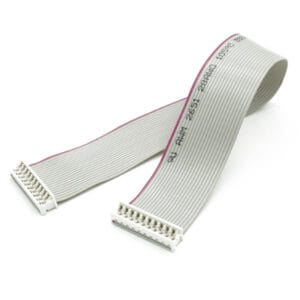端末の種類と形状
By ティナ / 2024年10月24日
端子(コンタクト)の形状とスタイル
リール端子とルースピース端子とは?
リール端子とルーズピース端子
図1は、ルースピースとストリップ・メス圧着端子を示す。どちらも圧着端子である。ルースピース端子は、安定性と信頼性を優先し、1つのインターフェイスポイントに接続します。ストリップ端子は、圧着効率を重視し、複数の接続用に直列またはリール状になっている。どちらも機械的な圧着を使用し、ワイヤー導体を端子内で固定し、安全で安定した電気接続を実現します。圧着には、特定のワイヤーサイズとストリップ長さが必要です。適切な圧着高さと端子内のワイヤー配置が重要です。ルースピース端子は20-24AWGのワイヤーに適合し、ストリップ端子は14-18AWGに適合する。どちらも自動車、コネクター、ワイヤーハーネスの用途に使用されます。
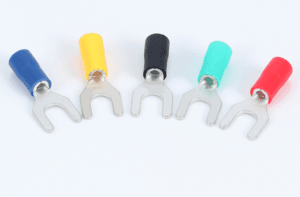
図2は、リング端子、スペード端子、U字端子、ピン端子、フェル ール端子、ブレード端子などの各種端子を示している。これらは、絶縁付きと絶縁なしがある。これらの端子は、圧着器やハンマーなどの工具を使用し、挿入と圧着、またははんだ付けと圧着によって接続される。適用されるワイヤーゲージは、端子サイズによって異なる。これらは、自動車、航空宇宙、産業用電子機器に使用される。
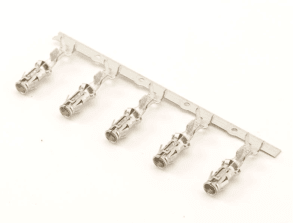
ブラインド圧着端子
ブラインド圧着端子とは?
ブラインド圧着端子は、端子の位置が見えないように圧着するもので、ホースの圧着位置のことで、電線の被覆をホースに挿入しながらタブを位置決めして圧着する。
電気接続によく使われる金属製コネクター。一般的にアルミニウムまたは銅製で、絶縁ブーツを備えていることが多く、圧着またははんだ付けによって電線や導線を接続し、電流や信号の伝送を可能にします。これらの端子は、絶縁または非絶縁(裸)バージョンとして利用可能で、さまざまな定格電流とアプリケーションに対応しています。端子タイプの選択は、アプリケーションの特定のニーズと使用環境によって異なります。ブラインド圧着端子は、取り付けが簡単で信頼性の高い性能を備えているため、電子機器、電気通信、その他さまざまな業界で広く使用されています。その汎用性と安全性が、広く採用されている理由です。
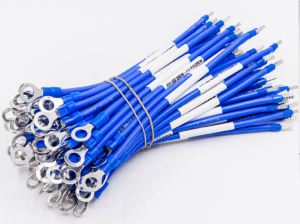
なぜ「ブラインド・クリンピング」と呼ばれるのか?
ブラインド圧着端子には、リング型、スペード型、U字型、ピン 型、フェルール型、ブレード型がある。これらの端子は、熱を加えずに接続され、室温で機械的な圧力を使って電線を端子に圧着します。加えられた力が端子を変形させ、ワイヤーとの強固な接続を作り、確実な信号と電流を流します。この冷間圧着法はシンプルであり、その効率性と実装の容易さから、様々な電気機器や配線システムに広く使用されている。熱を用いないため、はんだ付け法に比べて安全で汎用性が高い。
クイックコネクト端子(250、187、110)とは何ですか?なぜ「クイックコネクト」と呼ばれるのですか?
プッシュイン、スプリングケージ、ブレードタイプなどのクイックコネクト端子は、ワイヤ終端を簡単かつ迅速に行うことができます。その主な利点は、繰り返し抜き差しできることで、ワイヤ信号や電流の迅速な接続と切断を可能にし、作業効率を向上させ、メンテナンスや交換を簡素化します。この「プラグ・アンド・プレイ」機能により、回路の接続と切断のプロセスが合理化されます。
250、187、および110の呼称は、クイックコネク ト端子の特定のサイズとモデルを示し、すべてストレ ート、プッシュインタイプで、通常、用途環境に応じて PVC、ナイロン、またはゴム絶縁の真鍮製です。250端子は、高電圧または高電流アプリケーション(22~26AWG)に適しています。187端子は、中程度の電圧と電流(22~24AWG)に対応します。110端子は、低電圧および電流用途(16~24AWG)に対応。
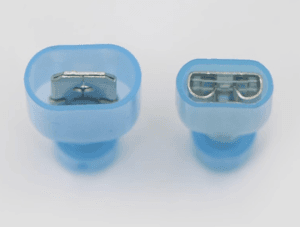
圧接コネクタ(IDC)とは? ヒント:PCBウェハーに直接挿入できます。
圧接コネクタ(IDC)は、はんだ付けの必要性を排除します。端子をコネクターハウジングに挿入し、次に被覆を剥いた電線を挿入すると、端子の特別に設計されたコンタクトブレードによって絶縁体が変位し、接続が完了します。これにより、気密性の高い接続が実現する。PCBでは、IDCは最小限の力で回路基板のトレースを貫通し、他のデバイスとの接続を確立することができます。IDCは再現性のある接続を提供し、はんだ付けよりも高速で効率的な接続を実現し、交換やメンテナンスが容易になります。
